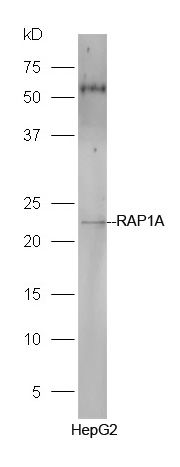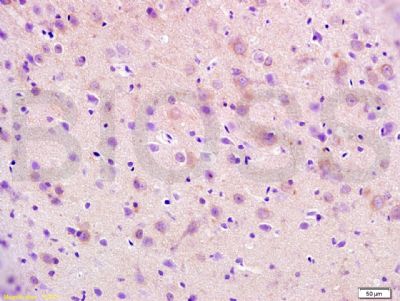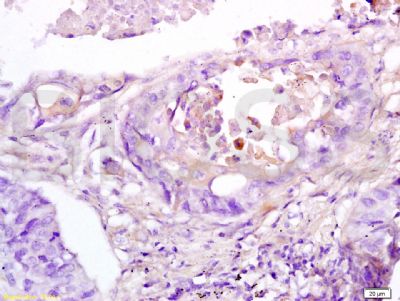This gene encodes a member of the Ras family of small GTPases. The encoded protein undergoes a change in conformational state and activity, depending on whether it is bound to GTP or GDP. This protein is activated by several types of guanine nucleotide exchange factors (GEFs), and inactivated by two groups of GTPase-activating proteins (GAPs). The activation status of the encoded protein is therefore affected by the balance of intracellular levels of GEFs and GAPs. The encoded protein regulates signaling pathways that affect cell proliferation and adhesion, and may play a role in tumor malignancy. Pseudogenes of this gene have been defined on chromosomes 14 and 17. Alternative splicing results in multiple transcript variants. [provided by RefSeq, May 2014].
Function:
Induces morphological reversion of a cell line transformed by a Ras oncogene. Counteracts the mitogenic function of Ras, at least partly because it can interact with Ras GAPs and RAF in a competitive manner. Together with ITGB1BP1, regulates KRIT1 localization to microtubules and membranes. Plays a role in nerve growth factor (NGF)-induced neurite outgrowth. Plays a role in the regulation of embryonic blood vessel formation. Involved in the establishment of basal endothelial barrier function. May be involved in the regulation of the vascular endothelial growth factor receptor KDR expression at endothelial cell-cell junctions.
Subunit:
Found in a complex, at least composed of ITGB1BP1, KRIT1 and RAP1A. Interacts (active GTP-bound form preferentially) with KRIT1 (via SLCterminus FERM domain); the interaction does not induce the opening conformation of KRIT1. In its GTP-bound form interacts with PLCE1 and RADIL. Interacts with SGSM1, SGSM2 and SGSM3. Interacts (via GTP-bound active form) with RAPGEF2 (via Ras-associating domain)
Subcellular Location:
Cell membrane; Lipid-anchor. Cytoplasm. Cytoplasm, perinuclear region. Cell junction. Early endosome. Note=Recruited from early endosome to late endosome compartment after nerve growth factor (NGF) stimulation. Localized with RAPGEF2 at cell-cell junctions. Colocalized with RAPGEF2 in the perinuclear region.
Similarity:
Belongs to the small GTPase superfamily. Ras family.
SWISS:
P62834
Gene ID:
5906
Database links:
Entrez Gene: 5906 Human
Entrez Gene: 109905 Mouse
Entrez Gene: 295347 Rat
Omim: 179520 Human
SwissProt: P62834 Human
SwissProt: P62835 Mouse
SwissProt: P62836 Rat
Unigene: 190334 Human
Unigene: 458171 Mouse
Unigene: 106321 Rat
RAP1A 是RAS癌基因家族成员,在调节细胞增生和粘附中有重要作用.经研究发现,Rap1和它的调节子SPA-1在很多恶性肿瘤的发生、发展中起到一定的作用。定位于胞浆、胞膜。
| Picture |
Sample:
HepG2 Cell (Human) Lysate at 30 ug
Primary: Anti-RAP1A (SL1504R) at 1/300 dilution
Secondary: IRDye800CW Goat Anti-Rabbit IgG at 1/20000 dilution
Predicted band size: 21 kD
Observed band size: 22 kD
Tissue/cell: mouse brain tissue; 4% Paraformaldehyde-fixed and paraffin-embedded;
Antigen retrieval: citrate buffer ( 0.01M, pH 6.0 ), Boiling bathing for 15min; Block endogenous peroxidase by 3% Hydrogen peroxide for 30min; Blocking buffer (normal goat serum,SLC0005) at 37℃ for 20 min;
Incubation: Anti-RAP1A Polyclonal Antibody, Unconjugated(SL1504R) 1:200, overnight at 4°C, followed by conjugation to the secondary antibody(SP-0023) and DAB(SLC0010) staining
Tissue/cell: human lung cancer tissue; 4% Paraformaldehyde-fixed and paraffin-embedded;
Antigen retrieval: citrate buffer ( 0.01M, pH 6.0 ), Boiling bathing for 15min; Block endogenous peroxidase by 3% Hydrogen peroxide for 30min; Blocking buffer (normal goat serum,SLC0005) at 37℃ for 20 min;
Incubation: Anti-RAP1A Polyclonal Antibody, Unconjugated(SL1504R) 1:200, overnight at 4°C, followed by conjugation to the secondary antibody(SP-0023) and DAB(SLC0010) staining
|
|
|


